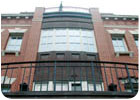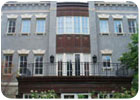
Emanating from the hundreds of surrounding brown and red brick homes in Chicago's well-known Lincoln Park is the Parrillo residence. Searching for a solution for what would soon become a monumental innovation in a well-known neighborhood, Storefitters Inc. called in the Italian paint specialists Atova International Inc. with hopes in finding an aesthetically efficient answer.
Lime paint, traditionally a masonry coating, exhibits strength and durability similar to stone and marble, an appealing characteristic many painters, builders and architects are now tuning into.
"We're finding more specifications for mineral-based paints because of their strengthening power, mold and mildew resistance, micro-crystallization and permeability," says Antonio Pinto, of Atova. "Add the flexibility of faux to this equation and we now have a material that is suitable for the exterior and for today's faux finisher."
Specifications that demand characteristics not found in some of today's standard coatings have lead many in the direction of mineral-based paints. Coatings, such as lime- and silicate-based paints, plasters and stucco, contain natural, inorganic substances, such as calcium oxide and calcium silicate. Primary minerals found in marble and Portland cement, these inorganic substances are solutions that lend significant strengths and flexibility for today's finisher.

"For one, we've applied a product traditionally used in warmer climates than the Midwest and two, we've applied it directly over brick without primers," says Pinto.
The main objective was to give the building's surface a sense of depth and age by creating a non-uniform surface. Typical of what might be seen when traveling to the south of France or visiting the famous villas in Tuscany.
A four-story home located in Lincoln Park, this corner lot is now the focal point of the entire neighborhood. Passersby and neighbors continually gather to entertain such a warm and welcoming visual presence, all done with a two-coat application of Atova's lime paint. Extremely opaque, lime paint can be diluted and applied many different ways. Debating over a Viscayan yellow and a steel blue-grey, the blue-grey seemed more practical.
In 10 days, Atova had several apprentices working to secure hanging scaffoldings; taping the hundreds of fresh lime-stone architectural details; finishers and master finishers aggressively applying a primary filler coat of lightly diluted lime paint to fill in the grout lines and create a foundation for the final coat; and a final coat applied by large specialty mineral paint brushes.

"What's even more surprising to our clients are the long-term benefits mineral paints possess," says Pinto. "The benefits include anti-molding and mildew protection, superior fire and smoke protection, advanced permeability and UV resistance. Mineral products truly protect surfaces by allowing moisture and steam to escape from the interior and blocking it from entering. This in turn, protects the insulation and framing, interior climate control, and promotes the excavation of atmospheric acids, salts, and sulfur rather than allowing for them to be trapped between the substrate and coatings."
Mineral products typically do not create a film over masonry surfaces. Instead, they work their way into the pores and crystallize. As they then consolidate, they re-open new channels for the surface to breath. Products such as lime paint, Marmorino and silicate stucco are essentially molten stone, suspended in water and preserved in sealed containers. Once they are applied and cured, they naturally fossilize with other inorganic surfaces, such as cement, stone and clay. The principal elements found in mineral-based products are oxide pigments and calcium, similarly used by ancient civilizations who created the frescos we know today. These same products have withstood the test of time and mustn't be ignored by today's modern finishers.
If you read this article, please circle number 171.
Tom Nesbitt is owner of Storefitters Inc.
Francesco Vittorio contributed to this article.

Report Abusive Comment